1988 was a leap year, and the year we took a leap of faith on how funky a project our students would sign up for. Noel was always pushing the edges of the miniatures world, while I was trying to maintain a steady flow of income. We were both smitten with roadside architecture of the 20s-30s–kitschy stands painted up like movie sets and tending to smell of rancid cooking oil. The miniature versions weren’t any more elegant, but they were romantic and iconic to a certain ilk. Pine Lake Park, the previous project, had been popular with enough to fill a class, but not enough to fill a second or third, which we needed in order not to burn ourselves out coming up with new work.
The stands were still new ground in miniatures—some thought it was fun to take a stab at, but many could not envision them in their collections next to their Victorians, Colonials, and British cottages. Funk was fun, but was it art? Historians had jacked up the genre to Vernacular Architecture, but few were familiar with the term. Plus there was the difficulty of students finishing the interior on their own.
The grills, fridges and deep fat fryers were not found on the greater miniature market, and our teaching focused on exterior aging. Still, we were fixated. As gas prices hit a shocking $1.00 a gallon, we rolled along into roadside stands, hoping to hook enough students aboard for the ride.
Another milestone for 1988 was that wonderfully silly movie, A Fish Called Wanda. Perhaps fish were in the air when we delved once again into John Baeder’s delightful Gas, Food and Lodging, finding his postcard reproduction of The Big Fish, a long, pike-ishly shaped drive-in on the shores of Lake Erie, remembered for serving up a grocery bag of fries for $1.00, along with the local fried fish.
The Big Fish was too big a stand for teaching, but we loved the fish idea. To size it down, we turned to a collection of the beautiful watercolors of Frank Stick, in the book, An Artist’s Catch. In it Noel found a little sunfish called a pumpkin seed, that came much closer to a class-size project. From pike to sunfish, whatever the magic was, we were on our way to a new roadside stand.
The world spun on. We worked our way through late winter, building the prototype while watching the Calgary Winter Olympics and the aftermath of the Lockerbie crash. Our teaching deadline wasn’t until the end of May, but we would be breaking for another mini cruise—this one the Nutshell News (a longtime miniatures magazine) Caribbean Cruise—in March.
To extend our working hours, we resorted to dining on Lean Cuisine in the studio. Our tables were the cutting boards that slid out from under the work table adapted from the defunct Kitchen Queen (aka Hoosier) we’d resurrected years before from the dump. We worked into the nights, spurred on by thoughts of the warm beaches and Caribbean sun we’d soon be basking in.
The cruise was restful and fun, except for the fact that our luggage didn’t catch up with us until two weeks after we returned home. We arrived on the ship after 16 hours of travel, a tad disheveled, each with nothing more to wear than a pair of shorts, a change of shirts, and our bathing suits–the important clothes. For the rest, our fellow miniatures passengers opened their closets to us, and for the next week we lived as very well-dressed people quite different from ourselves. There is photographic evidence of Noel in a borrowed madras plaid jacket and pink tie, and me in a beautiful white crocheted dress and shawl, dining at the ship’s doctor’s table with Sybil Harp (the magazine editor) and the Arnells. I think we wore the same thing every night. I have no idea what we taught, if anything.
Fish & Fries was well-received in Castine, and despite my concerns, the class re-booked several times afterward, and was mourned when we stopped offering it. Everyone did well in the first class, with a minor blip. Late in the week a tearful student discovered she’d inadvertently flipped the front flap and lettered it (Gone Fishing) upside down. Luckily it was on the back of the flap, only visible when (and if) the stand was “closed”, not the normal way of displaying it. I think we convinced her it was okay just to leave it open, and all would be well—the rest of her work looked great. After all, this was a recreational class, and the only thing at stake was to have a good time. Hers is the one hidden at the bottom.
Despite the students groaning and hours of hard work, I was always amazed at how well everyone took on the daunting bunch of lettering and painting styles Noel cooked up. The stands were popular–we and our students were on the road, so to speak, toward building ever more offbeat structures.


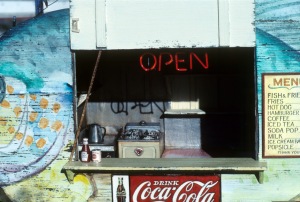
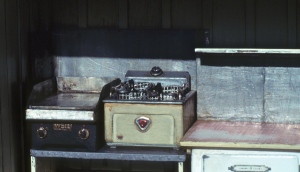
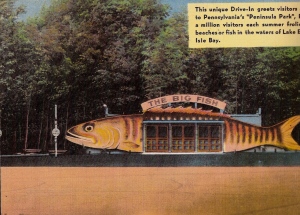
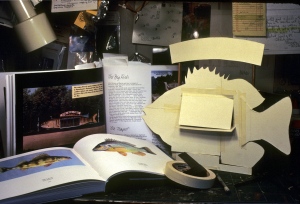

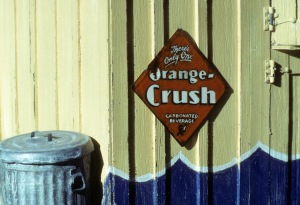
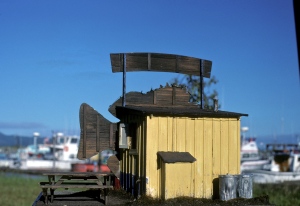
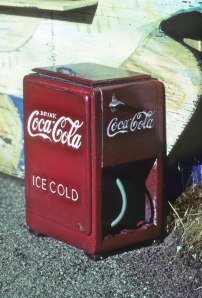
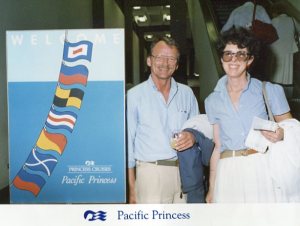



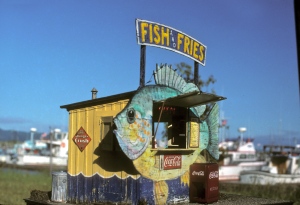
HA love it 🙂 It’s so fun to open the pictures in new tabs and blow them up, such amazing detail—
Thank you for sharing this fun structure! All your work are amazing but I’ve always been particularly enamored with the Fish Stand. Thank you also for saving them as large jpegs so we can see the wonderful detail! I wish I was able to take this class (or any class!) but your description and pictures are the next best thing! God bless you both. ❤
JudyK
Thanks, and it’s really the magic of Word Press, my host site, that makes the pictures look that good.
Your houses are my favorites of your work but the Beach Cottage and Fish and Fries are my all time favorites of your smaller projects. Thank you for sharing the large pictures to see the details. I LOVE this piece. Thank you for all the years of creativity. Julie Littlejohn
Noel and Pat, I was sorry to see you retire, but I understand that even something you love can wear you out. For me it was the traveling even though I limited myself to a half dozen or fewer each year. I have always (yes all the way back to the 80’s) admired your work – though old and used looking it was a fresh and new approach to miniature architecture. I loved the green Victorian house you did way back when. I hope I find it here now that I have found your blog. I am very anxious to feed my passion by visiting all of your blog pages!! Thanks for sharing. Kathy Moore, Scale Designs and Cassidy Creations (since about 1995 – prior owners were Pat Bauder and Frank Moroz.)
Hi Kathy, Glad to hear you’re enjoying the blog. More to come soon.
Enjoyed your post and pics so much. I had seen one that a friend and done, and only at the end and picture did I realize it was Mry Oberlender, second from the right in the Castine class picture.
Your work is wonderful. A true inspiration. I have to say, I love the idea of a miniature cruise to the Caribbean!
Glad you’re enjoying the blog, and yes, the cruise was fun!
Pat — I’d like to send a personal email to you — it’s very long — could you please contact me.
Some of us are trying to determine what the back ground location is ?
We think it is SF Bay area.. can you shed some light on it.. driving me nuts !
It’s the tiny port of Ilwaco, WA, just around the corner from the mouth of the Columbia River.